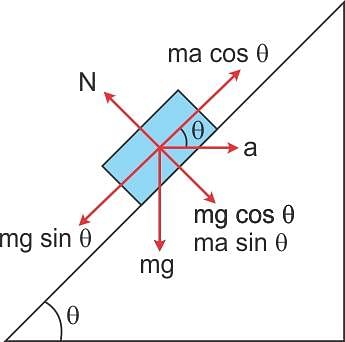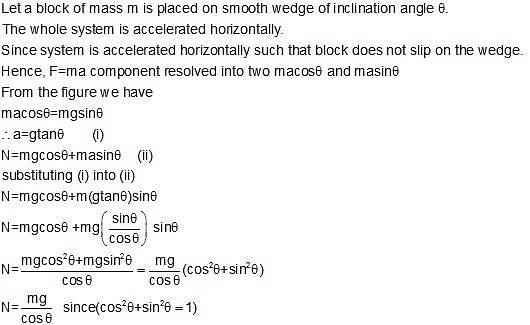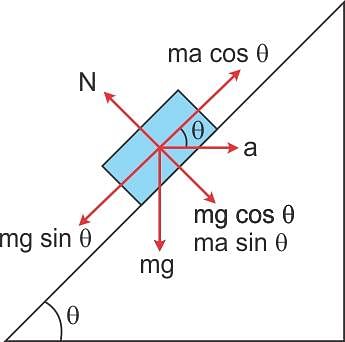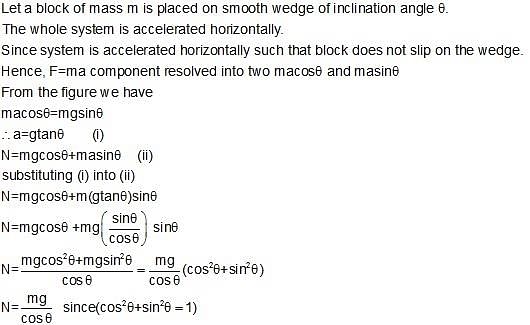JEE Exam > JEE Questions > A block of mass m is placed on a smooth wedge...
Start Learning for Free
A block of mass m is placed on a smooth wedge of inclination theta. The whole system is accelerated horizontally so that the block does not slip on the wedge. The force exerted by the wedge on the block has a magnitude.? Can you answer this?
Verified Answer
A block of mass m is placed on a smooth wedge of inclination theta. Th...
Ans.


 This question is part of UPSC exam. View all JEE courses
This question is part of UPSC exam. View all JEE courses
Most Upvoted Answer
A block of mass m is placed on a smooth wedge of inclination theta. Th...
Force Exerted by Wedge on Block in an Inclined Plane System
Introduction:
In this scenario, a block of mass m is placed on a smooth wedge inclined at an angle θ. The entire system is accelerated horizontally in such a way that the block does not slip on the wedge. We need to determine the magnitude of the force exerted by the wedge on the block.
Analysis:
To solve this problem, we will break down the forces acting on the block and analyze them separately. There are two main forces acting on the block:
1. Gravitational Force (Weight):
The weight of the block can be decomposed into two components: one parallel to the inclined plane (mg sin θ) and the other perpendicular to the inclined plane (mg cos θ).
2. Normal Force:
The normal force acts perpendicular to the inclined plane and opposes the component of the weight perpendicular to the plane. It prevents the block from sinking into the wedge. The normal force can be decomposed into two components: one parallel to the inclined plane and the other perpendicular to the inclined plane.
Force Analysis:
- The force exerted by the wedge on the block can be divided into two components: one perpendicular to the inclined plane (Fn ⊥) and one parallel to the inclined plane (Fn //).
- The perpendicular component of the force (Fn ⊥) is equal in magnitude and opposite in direction to the component of the weight perpendicular to the inclined plane, i.e., Fn ⊥ = mg cos θ.
- Since the block is not slipping on the wedge, the parallel component of the force (Fn //) must cancel out the component of the weight parallel to the inclined plane, i.e., Fn // = mg sin θ.
Result:
Therefore, the magnitude of the force exerted by the wedge on the block is equal to the component of the weight perpendicular to the inclined plane, which can be calculated as:
|Fn| = √(Fn ⊥² + Fn //²)
= √((mg cos θ)² + (mg sin θ)²)
= √(m²g² cos² θ + m²g² sin² θ)
= √(m²g² (cos² θ + sin² θ))
= √(m²g²)
= mg
Thus, the magnitude of the force exerted by the wedge on the block is equal to its weight, which is mg.
Introduction:
In this scenario, a block of mass m is placed on a smooth wedge inclined at an angle θ. The entire system is accelerated horizontally in such a way that the block does not slip on the wedge. We need to determine the magnitude of the force exerted by the wedge on the block.
Analysis:
To solve this problem, we will break down the forces acting on the block and analyze them separately. There are two main forces acting on the block:
1. Gravitational Force (Weight):
The weight of the block can be decomposed into two components: one parallel to the inclined plane (mg sin θ) and the other perpendicular to the inclined plane (mg cos θ).
2. Normal Force:
The normal force acts perpendicular to the inclined plane and opposes the component of the weight perpendicular to the plane. It prevents the block from sinking into the wedge. The normal force can be decomposed into two components: one parallel to the inclined plane and the other perpendicular to the inclined plane.
Force Analysis:
- The force exerted by the wedge on the block can be divided into two components: one perpendicular to the inclined plane (Fn ⊥) and one parallel to the inclined plane (Fn //).
- The perpendicular component of the force (Fn ⊥) is equal in magnitude and opposite in direction to the component of the weight perpendicular to the inclined plane, i.e., Fn ⊥ = mg cos θ.
- Since the block is not slipping on the wedge, the parallel component of the force (Fn //) must cancel out the component of the weight parallel to the inclined plane, i.e., Fn // = mg sin θ.
Result:
Therefore, the magnitude of the force exerted by the wedge on the block is equal to the component of the weight perpendicular to the inclined plane, which can be calculated as:
|Fn| = √(Fn ⊥² + Fn //²)
= √((mg cos θ)² + (mg sin θ)²)
= √(m²g² cos² θ + m²g² sin² θ)
= √(m²g² (cos² θ + sin² θ))
= √(m²g²)
= mg
Thus, the magnitude of the force exerted by the wedge on the block is equal to its weight, which is mg.
Community Answer
A block of mass m is placed on a smooth wedge of inclination theta. Th...
Ans.


Attention JEE Students!
To make sure you are not studying endlessly, EduRev has designed JEE study material, with Structured Courses, Videos, & Test Series. Plus get personalized analysis, doubt solving and improvement plans to achieve a great score in JEE.

|
Explore Courses for JEE exam
|

|
Similar JEE Doubts
A block of mass m is placed on a smooth wedge of inclination theta. The whole system is accelerated horizontally so that the block does not slip on the wedge. The force exerted by the wedge on the block has a magnitude.? Can you answer this?
Question Description
A block of mass m is placed on a smooth wedge of inclination theta. The whole system is accelerated horizontally so that the block does not slip on the wedge. The force exerted by the wedge on the block has a magnitude.? Can you answer this? for JEE 2024 is part of JEE preparation. The Question and answers have been prepared according to the JEE exam syllabus. Information about A block of mass m is placed on a smooth wedge of inclination theta. The whole system is accelerated horizontally so that the block does not slip on the wedge. The force exerted by the wedge on the block has a magnitude.? Can you answer this? covers all topics & solutions for JEE 2024 Exam. Find important definitions, questions, meanings, examples, exercises and tests below for A block of mass m is placed on a smooth wedge of inclination theta. The whole system is accelerated horizontally so that the block does not slip on the wedge. The force exerted by the wedge on the block has a magnitude.? Can you answer this?.
A block of mass m is placed on a smooth wedge of inclination theta. The whole system is accelerated horizontally so that the block does not slip on the wedge. The force exerted by the wedge on the block has a magnitude.? Can you answer this? for JEE 2024 is part of JEE preparation. The Question and answers have been prepared according to the JEE exam syllabus. Information about A block of mass m is placed on a smooth wedge of inclination theta. The whole system is accelerated horizontally so that the block does not slip on the wedge. The force exerted by the wedge on the block has a magnitude.? Can you answer this? covers all topics & solutions for JEE 2024 Exam. Find important definitions, questions, meanings, examples, exercises and tests below for A block of mass m is placed on a smooth wedge of inclination theta. The whole system is accelerated horizontally so that the block does not slip on the wedge. The force exerted by the wedge on the block has a magnitude.? Can you answer this?.
Solutions for A block of mass m is placed on a smooth wedge of inclination theta. The whole system is accelerated horizontally so that the block does not slip on the wedge. The force exerted by the wedge on the block has a magnitude.? Can you answer this? in English & in Hindi are available as part of our courses for JEE.
Download more important topics, notes, lectures and mock test series for JEE Exam by signing up for free.
Here you can find the meaning of A block of mass m is placed on a smooth wedge of inclination theta. The whole system is accelerated horizontally so that the block does not slip on the wedge. The force exerted by the wedge on the block has a magnitude.? Can you answer this? defined & explained in the simplest way possible. Besides giving the explanation of
A block of mass m is placed on a smooth wedge of inclination theta. The whole system is accelerated horizontally so that the block does not slip on the wedge. The force exerted by the wedge on the block has a magnitude.? Can you answer this?, a detailed solution for A block of mass m is placed on a smooth wedge of inclination theta. The whole system is accelerated horizontally so that the block does not slip on the wedge. The force exerted by the wedge on the block has a magnitude.? Can you answer this? has been provided alongside types of A block of mass m is placed on a smooth wedge of inclination theta. The whole system is accelerated horizontally so that the block does not slip on the wedge. The force exerted by the wedge on the block has a magnitude.? Can you answer this? theory, EduRev gives you an
ample number of questions to practice A block of mass m is placed on a smooth wedge of inclination theta. The whole system is accelerated horizontally so that the block does not slip on the wedge. The force exerted by the wedge on the block has a magnitude.? Can you answer this? tests, examples and also practice JEE tests.

|
Explore Courses for JEE exam
|

|
Suggested Free Tests
Signup for Free!
Signup to see your scores go up within 7 days! Learn & Practice with 1000+ FREE Notes, Videos & Tests.

























